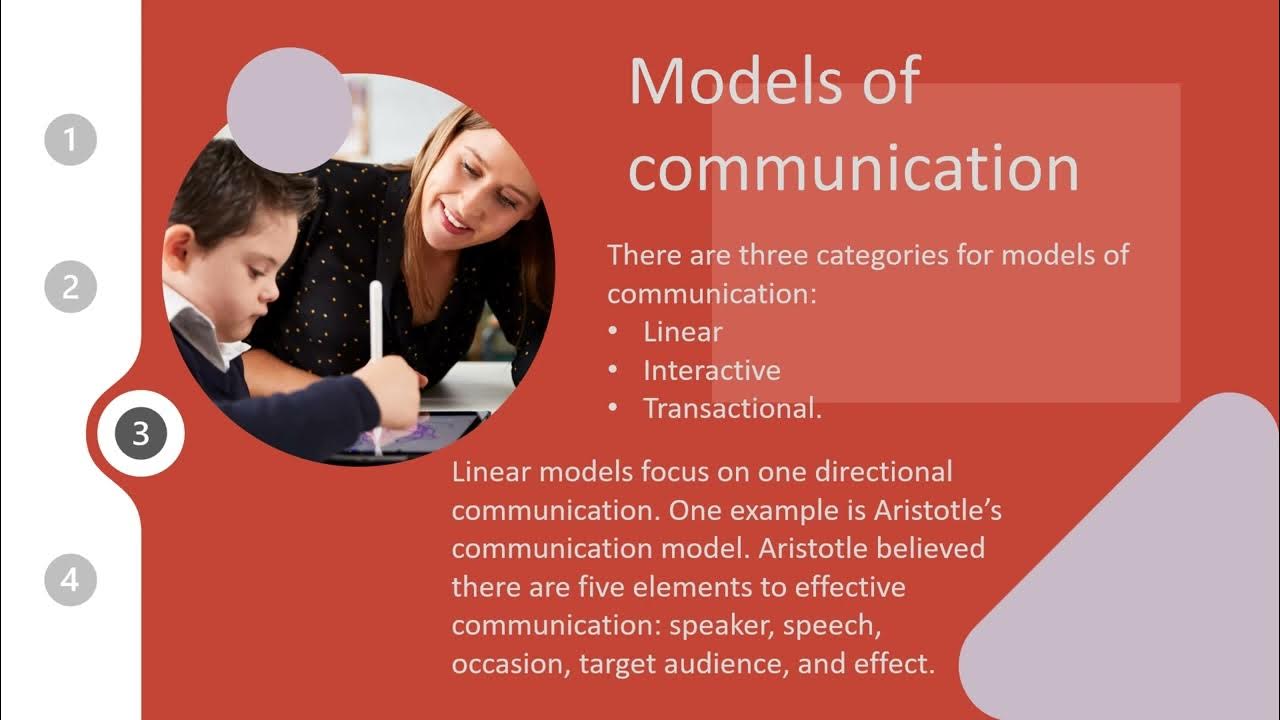Transactional Communication Model
Summary
TLDRThis video script delves into the transactional communication model, a framework for understanding and visualizing communication patterns in conflict. It emphasizes the ongoing process of meaning co-creation through message exchange and interpretation. The script discusses the importance of recognizing communicator characteristics, shared and unique experiences, and the impact of different communication channels, including the rise of technology like Zoom. It highlights the distinction between content and relational messages, the influence of noise, and the role of relational and contextual factors in shaping communication within conflicts.
Takeaways
- 🗣️ Interpersonal communication is an ongoing process of co-creating meaning through the exchange of messages between parties.
- 📦 Meaning is not directly transmitted but is co-created through a process of encoding, sending, decoding, and interpreting messages.
- 👤 The characteristics of communicators, including their communication styles and fields of experience, influence how messages are conveyed and received.
- 🌐 Fields of experience shape our values, perceptions, and mental models, which in turn affect our communication, especially in conflict situations.
- 🔁 Communication involves both shared and unique experiences that can either facilitate or challenge the understanding between communicators.
- 📡 Channels of communication include face-to-face and mediated forms, with each having distinct implications for message transmission.
- 🌐 Face-to-face communication encompasses verbal and nonverbal cues, while mediated communication relies on technology to convey messages.
- 🔄 The distinction between content and relational messages is crucial in conflict analysis, with content focusing on the topic and relational on feelings and relationships.
- 👁️ Paying attention to relational messages is vital as they often reinforce pre-existing assumptions about others, especially in conflicts.
- 👂 Noise, both external and internal, can interfere with communication, affecting the clarity and reception of messages.
- 🔍 Analyzing communication patterns within a conflict requires considering various factors including the history of interactions, power dynamics, and contextual norms.
Q & A
What is the basic definition of interpersonal communication according to the video?
-Interpersonal communication is defined as a constant, ongoing process of co-creating meaning through the sending/receiving, decoding, and interpreting of messages between two or more parties.
Why is it said that we cannot not communicate?
-Even when we are not speaking, we are still communicating through non-verbal cues such as body language, eye contact, and the way we occupy space. Ignoring someone is also a form of communication.
What does it mean when the video mentions that 'meaning is co-created'?
-Meaning is co-created because it involves a process where messages are encoded, sent, received, decoded, and interpreted by the recipient, rather than being directly transmitted without alteration.
What are the characteristics of the communicators that should be considered when analyzing communication patterns within a conflict?
-The characteristics include communication styles, fields of experience, values, perceptions, beliefs, and mental models that shape how individuals communicate.
What is the significance of shared fields of experience in communication?
-Shared fields of experience can make communication more fluid as they provide a common ground for understanding, such as a shared language or common experiences in a classroom setting.
How does the video differentiate between face-to-face and mediated communication channels?
-Face-to-face communication is direct and includes both verbal and nonverbal cues, while mediated communication involves technological means such as letters, text messages, emails, and phone calls.
What is the role of nonverbal behavior in face-to-face communication?
-Nonverbal behavior in face-to-face communication includes body movement, posture, and proximity to others, which often convey feelings about the situation or the other person.
What is the distinction between content and relational messages in communication?
-Content messages are about the topic or information being conveyed, while relational messages convey feelings about the other person, the relationship, or the interaction, often through nonverbal means.
Why is it important to pay attention to relational messages in conflict situations?
-In conflict situations, people are more attuned to relational messages as they look for cues that reinforce their pre-existing assumptions about the other person, which can be conveyed through body language and tone of voice.
What are the different types of noise that can interfere with communication?
-The types of noise include external noise (environmental factors), physiological noise (bodily states), and psychological noise (emotions and intrusive thoughts).
How do contextual factors impact communication patterns?
-Contextual factors such as institutional norms and accepted ways of interacting can greatly influence the dynamics of communication, making it different in various settings like a classroom or a social gathering.
Outlines

Cette section est réservée aux utilisateurs payants. Améliorez votre compte pour accéder à cette section.
Améliorer maintenantMindmap

Cette section est réservée aux utilisateurs payants. Améliorez votre compte pour accéder à cette section.
Améliorer maintenantKeywords

Cette section est réservée aux utilisateurs payants. Améliorez votre compte pour accéder à cette section.
Améliorer maintenantHighlights

Cette section est réservée aux utilisateurs payants. Améliorez votre compte pour accéder à cette section.
Améliorer maintenantTranscripts

Cette section est réservée aux utilisateurs payants. Améliorez votre compte pour accéder à cette section.
Améliorer maintenant5.0 / 5 (0 votes)






